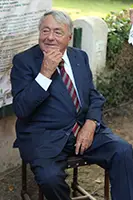Claude Lanzmann
(1925 – 2018)

Claude Lanzmann was a journalist and film director who make a singular mark on Holocaust memorialization and documentary film with his film Shoah (1985).
Lanzmann was born on November 27, 1925, in Paris, France. He was the son of assimilated French Jews who had immigrated to France from Eastern Europe. Lanzmann attended the Lycée Blaise-Pascal in Clermont-Ferrand.
While his family disguised their identity and went into hiding during World War II, Claude joined the French resistance at the age of 17 and fought along with his father and brother in Auvergne.
After the war, he studied philosophy in at the University of Tübingen and taught at the Free University of Berlin. He befriended Jean-Paul Sartre and was romantically involved with Simone de Beauvoir. Mr. Lanzmann eventually became editor of Sartre’s journal Les Temps Modernes.
Lanzmann opposed the French war in Algeria and signed the 1960 antiwar petition Manifesto of the 121.
Shoah is a nine-hour film that combines documentary and what Mr. Lanzmann called “a fiction of the real.” It was consciously artful, he said, so as to “make the unbearable bearable.”
Lanzmann appears as a facilitator, eliciting memories from the survivors, bystanders, and perpetrators. Yet the force of his personality comes through in his questions and the persistent and at times brutal ways in which he asks them.
Shoah — Hebrew for catastrophe — chronicles the Nazi extermination of six million Jews in World War II. His film contains no archival images of the gas chambers or the living skeletons that Allied forces discovered. Rather, Lanzmann tracked down and interviewed living witnesses: officers and bureaucrats who had run the camps; Jewish survivors, veterans of the 1943 uprising in the Warsaw ghetto; and Polish townspeople near Auschwitz.
Lanzmann’s technique was compelling because he forced his interviewees to remember their most terrible experiences on camera. Questioned as to the morality of making those who suffered reveal their horror on screen, Lanzmann said: “One has to die with them again in order that they didn’t die alone.”
He was the film-maker-as-spy, pretending to be pro-Nazi to access former Nazis and filming with a camera hidden in his handbag. In 1979, he was badly beaten when his ruse was discovered.
He was impatient with efforts to “explain” the Holocaust. “To ask why the Jews have been killed is a question that shows immediately its own obscenity.” He also rejected efforts to make uplifting entertainment from the Holocaust: “Shoah is not about survival, It’s about death.”
The 350 hours of footage he made for Shoah was later used to make other Holocaust films.
The Karski Report (2010) chronicles the life of Polish resistance hero Jan Karski who visited the Warsaw ghetto and travelled to the U.S. to warn the Allies about what was happening to the Jews of Europe.
The Last of the Unjust, (2013) explores the life of Benjamin Murmelstein, the Austrian rabbi who was the last appointed head of the Council of Elders in Theresienstadt.
Shoah: Four sisters (2017) shows the war experiences of four women who survived the war.
He made two films about the Jewish state: Pourquoi Israël.(Why Israel) (1973) and Tsahal (1994).
Mr. Lanzmann was a dominating, outspoken and cantankerous figure in French intellectual and public life. He was a critic of colonialism who also defended Israel. His autobiography, The Patagonian Hare, was published in 2009.
The Claude Lanzmann Shoah Collection is jointly owned by the United States Holocaust Memorial Museum and Yad Vashem.
Lanzmann won several French honors, including the Grand Cross of the National Order of Merit, the Resistance Medal, and he was named a Grand Officer of the Legion of Honor. The University of Lucerne awarded him an honorary doctorate.
From 1952 to 1959, he lived with Simone de Beauvoir. In 1963, he married French actress Judith Magre. After a divorce, he married Angelika Schrobsdorff, a German-Jewish writer. He divorced a second time and married Dominique Petithory in 1995. He was the father of three children.
Lanzmann died on July 5, 2018, at his Paris home. He was 92.
Sources: Julia Pascal, “Claude Lanzmann obituary,” The Guardian, (July 5, 2018).
Adam Kirsch, “Chasing Death,” Jewish Review of Books, (Spring 2012).
Timothy Snyder, “The Holocaust We Don’t See: Lanzmann’s ‘Shoah’ Revisited,” New York Review, (December 15, 2010).
Daniel Lewis, “Claude Lanzmann, Epic Chronicler of the Holocaust, Dies at 92,” New York Times, (July 5, 2018).
Jonathan Derbyshire, “Claude Lanzmann, film-maker, 1925-2018,” Financial Times, (July 13, 2018).
“Claude Lanzmann,” Wikipedia.
Photo: ActuaLitté, CC BY-SA 2.0 via Wikimedia Commons.


